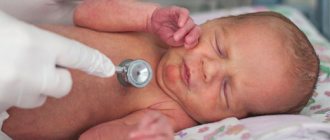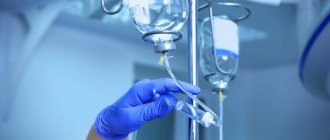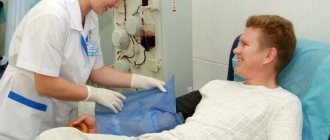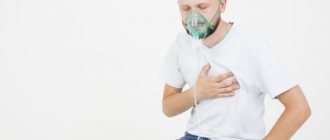Shortness of breath (dyspnea) is a painful feeling of lack of air, in extreme terms taking the form of suffocation.
If shortness of breath occurs in a healthy person against the background of physical activity or severe psycho-emotional stress, it is considered physiological. Its cause is the body's increased need for oxygen. In other cases, shortness of breath is caused by some disease and is called pathological.
According to the difficulty of the inhalation or exhalation phase, shortness of breath is distinguished as inspiratory and expiratory, respectively. A variant of mixed shortness of breath with limitation of both phases is also possible.
There are several types of shortness of breath. Dyspnea is considered subjective if the patient feels difficulty breathing, dissatisfaction with inhalation, but this cannot be measured and there are no factors for its occurrence. Most often it is a symptom of hysteria, neurosis, and thoracic radiculitis. Objective shortness of breath is characterized by a violation of the frequency, depth of breathing, duration of inhalation or exhalation, as well as increased work of the respiratory muscles.
Diseases associated with shortness of breath
In diseases of the respiratory system, shortness of breath may be the result of an obstruction in the airways or a decrease in the respiratory surface area of the lungs.
An obstruction in the upper respiratory tract (foreign body, tumor, accumulation of sputum) makes it difficult to inhale and pass air to the lungs, thereby causing inspiratory dyspnea. Reducing the lumen of the final sections of the bronchial tree - bronchioles, small bronchi due to inflammatory edema or spasm of their smooth muscles prevents exhalation, causing expiratory shortness of breath. In the case of narrowing of the trachea or large bronchus, shortness of breath takes on a mixed character, which is associated with the limitation of both phases of the respiratory act.
Mixed shortness of breath will also be due to inflammation of the lung parenchyma (pneumonia), atelectasis, tuberculosis, actinomycosis (fungal infection), silicosis, pulmonary infarction or compression from the outside by air, fluid in the pleural cavity (with hydrothorax, pneumothorax). Severe mixed shortness of breath up to suffocation is observed with pulmonary embolism. The patient takes a forced sitting position with support on his hands. Choking in the form of a sudden attack is a symptom of asthma, bronchial or cardiac.
With pleurisy, breathing becomes shallow and painful; a similar picture is observed with chest injuries and inflammation of the intercostal nerves, damage to the respiratory muscles (with poliomyelitis, paralysis, myasthenia gravis).
Shortness of breath in heart disease is a fairly common and diagnostically significant symptom. The cause of shortness of breath here is a weakening of the pumping function of the left ventricle and stagnation of blood in the pulmonary circulation.
The severity of heart failure can be judged by the degree of shortness of breath. At the initial stage, shortness of breath appears during physical activity: climbing stairs more than 2-3 floors, walking uphill, against the wind, moving at a fast pace. As the disease progresses, it becomes difficult to breathe even with slight exertion, when talking, eating, walking at a calm pace, or lying horizontally. In the severe stage of the disease, shortness of breath occurs even with minimal exertion and any actions, such as getting out of bed, moving around the apartment, bending the body, entail a feeling of lack of air. In the final stage, shortness of breath is present even at rest.
Attacks of severe shortness of breath, suffocation that occur after physical, psycho-emotional stress or suddenly, often at night, during sleep are called cardiac asthma. The patient is in a forced sitting position. Breathing becomes noisy, bubbling, audible at a distance. The release of foamy sputum may be observed, which indicates the onset of pulmonary edema; the participation of auxiliary muscles in the act of breathing and retraction of the intercostal spaces are noticeable to the naked eye.
In addition, shortness of breath in combination with chest pain, palpitations, and interruptions in cardiac function can be a sign of acute myocardial infarction, rhythm disturbances (paroxysmal tachycardia, atrial fibrillation) and is caused by a sharp decrease in heart function, a decrease in perfusion and oxygen supply to organs and tissues.
A group of blood diseases, one of the symptoms of which is shortness of breath, includes anemia and leukemia (tumor diseases). Both are characterized by a decrease in the level of hemoglobin and red blood cells, the main role of which is oxygen transport. Accordingly, oxygenation of organs and tissues deteriorates. A compensatory reaction occurs, the frequency and depth of breathing increases - thereby the body begins to consume more oxygen from the environment per unit of time.
The simplest and most reliable method for diagnosing these conditions is a general blood test.
Another group is endocrine (thyrotoxicosis, diabetes mellitus) and hormonally active diseases (obesity).
With thyrotoxicosis, the thyroid gland produces an excess amount of hormones, under the influence of which all metabolic processes are accelerated, metabolism and oxygen consumption increase. Here, shortness of breath, as with anemia, is compensatory in nature. In addition, high levels of T3 and T4 increase the work of the heart, contributing to rhythm disturbances such as paroxysmal tachycardia, atrial fibrillation with the consequences mentioned above.
Shortness of breath in diabetes mellitus can be considered a consequence of diabetic microangiopathy, leading to impaired trophism and oxygen starvation of cells and tissues. The second link is kidney damage - diabetic nephropathy. The kidneys produce the hematopoietic factor erythropoietin, and its deficiency causes anemia.
With obesity, as a result of the deposition of adipose tissue in the internal organs, the work of the heart and lungs is hampered, and the excursion of the diaphragm is limited. In addition, obesity is often accompanied by atherosclerosis and hypertension, which also entails disruption of their function and the occurrence of shortness of breath.
Shortness of breath to the point of suffocation can be observed with various types of systemic poisoning. The mechanism of its development includes an increase in the permeability of the vascular wall at the microcirculatory level and toxic pulmonary edema, as well as direct damage to the heart with disruption of its function and stagnation of blood in the pulmonary circulation.
Why is there not enough air when breathing?
Lack of air in healthy people occurs due to the fact that their body receives less oxygen than it needs. It manifests itself during physical exertion, heavy work, climbing, or stress. There are times when the feeling of lack of air is provoked by too tight clothing, squeezing the body.
In older people, it occurs due to age-related changes in the heart and blood vessels and manifests itself even with light loads. In addition, difficulty breathing, as already mentioned, is part of the symptomatic complex of a number of pathological conditions. If you experience it regularly, you need to seek professional medical help in order to accurately determine the cause. The most common of them are:
- Staying in a poorly ventilated room with stale air;
- Unhealthy lifestyle, accompanied by frequent alcohol consumption and smoking;
- A number of lung diseases;
- Pathologies of the cardiovascular system;
- Traumatic chest injuries.
Another initiating factor is the second half of pregnancy. During this period, the uterus seriously increases in volume and provokes the diaphragm to press upward, which does not allow the woman to breathe as deeply as she is used to. The longer the period, the stronger and more often the deficiency is felt, and it occurs not only with minor loads, but also when walking, accompanied by slight dizziness or darkening of the eyes.
The above is especially pronounced in patients carrying twins, triplets, or just a large baby, or suffering from an obstetric anomaly such as polyhydramnios, in which there is an increased volume of amniotic fluid. The problem is particularly alarming against the background of inferior vena cava compression syndrome. When it is present, a woman not only finds it difficult to breathe and lacks air, but also experiences severe dizziness, sudden weakness, fainting and a serious drop in blood pressure.
1.What is shortness of breath?
Shortness of breath (dyspnea)
is a subjective state characterized by dissatisfaction with breathing against the background of its intensification. Various breathing problems can occur with many diseases. However, the term “shortness of breath” refers specifically to the feeling that even rapid breathing does not compensate for the lack of air.
The subjective psychological perception of this phenomenon is always negatively colored; the vital fear it evokes is associated with the inability to control this process and available ways to alleviate one’s condition. Sometimes a feeling of shortness of breath can occur against the background of objectively completely normal breathing parameters (its rhythm, depth and frequency).
A must read! Help with treatment and hospitalization!
What is an “apnea attack”
Some patients tell their doctor that they regularly experience “apnea attacks.” By this they usually mean awakening from lack of air to the point of feeling suffocated, with a feeling of “not breathing,” a rapid heartbeat and a feeling of anxiety. Some patients compare these sensations to emerging from under water after holding their breath for too long. Usually this episode resolves quickly on its own, just take a few deep breaths and exhales. However, such suffocating awakenings often frighten a person, and because of this, his sleep becomes torn and is often filled with nightmares.
Constant awakenings due to lack of air quickly incapacitate even the most balanced and resilient people
Of course, any somnologist - a specialist who deals with problems of sleep and breathing during sleep - could correct such a patient and say that it is more correct to speak not about an attack, but about an “episode of apnea.” But doctors usually understand their patients very well: what for a specialist is an episode, a symptom of a disease, for the patient looks like a real attack, causing serious physical and emotional discomfort and even, often, instilling serious fear - the fear of suffocating at some point. time to sleep. After all, a sudden feeling of a sharp lack of air, and at the same time tearing him out of a state of sleep, can frighten even the most resilient and balanced person.
However, somnologists know that obstructive apnea most often occurs without conscious awakenings. Typically, an episode of apnea ends with brain activation - a kind of micro-awakening, when the brain, stimulated by a lack of oxygen, wakes up for a moment and, having given the command to start breathing, goes back to sleep. Breathing is restored, and the person, not having time to realize and remember what happened, again falls asleep in a ragged, anxious, restless sleep, but few of the patients then associate this specifically with stopping breathing. As a result, most patients are unaware of the problems that occur to them during the night.
So, most often, patients with obstructive sleep apnea complain of an “attack of apnea” when they begin to consciously awaken at night with a lack of air, with a feeling of previously absent breathing, rapid heartbeat and other unpleasant sensations.
Shortness of breath in a child
Most often, shortness of breath in children has the same causes and develops in the same way as in adults. Specific cases occur in newborns whose mothers suffer from heart disease and diabetes. The child may develop pulmonary edema - the so-called respiratory distress syndrome . Also, shortness of breath becomes one of the obvious manifestations of heart disease . Certain respiratory diseases in children cause difficulty breathing: laryngitis, false croup .
Diagnosis of air shortage
The initial stages of diagnosis are usually carried out by a therapist. He carries out an examination and collects anamnesis, after which, after analyzing the data obtained, he sends the patient to specialized specialists. To clarify the diagnosis, the latter prescribe the following studies:
- Chest X-ray to detect diseases and injuries;
- Electrocardiography - aimed at identifying heart disease;
- Spirometry - examines the functions of external respiration;
- Laryngoscopy - detects foreign bodies and diseases of the larynx.
4.Prevention of shortness of breath
Shortness of breath is often a harmless phenomenon and passes without special measures. However, you need to be attentive to this symptom if it repeats too often, and especially during those loads that previously passed without difficulty breathing. The occurrence of shortness of breath during movement in some cases can be a sign of serious disorders in the body. If you are sure that you are healthy, but your breathing is still impaired with increasing physical activity, there may be a number of reasons for this that you should try to eliminate on your own:
- reduce weight;
- lead a more active lifestyle;
- engage in feasible regular training (swimming, dancing, physical therapy, running);
- increase stress resistance, refuse excess information;
- take measures to increase immunity;
- quit smoking.
How to get rid of shortness of breath after coronavirus: drugs and procedures
If there is severe shortness of breath after coronavirus and pneumonia, treatment should be prescribed and its effectiveness monitored by a pulmonologist or therapist. The following medications may be prescribed.
- Bronchodilators. Necessary for those who, due to coronavirus, have increased hyperreactivity of the respiratory tract to various irritants, allergens, and asthmatic manifestations.
- Mucolytics. Needed for accumulation of viscous, poorly discharged mucus in the lower respiratory tract. They help to liquefy it, which makes it easier to remove sputum.
- Secretomotor means. Stimulate expectoration at the reflex level.
- Immunomodulators . They will be useful to all those who have recovered from Covid, since resistance to the new coronavirus literally exhausts the immune system, which slows down recovery.
- Antibiotics. May be necessary in case of bacterial infection of lungs weakened by Covid.
In case of shortness of breath due to cardiovascular or psychosomatic disorders, specialists should also prescribe appropriate medications.
However, it should be taken into account that an excessive drug load on an organism weakened by the virus and previous drug therapy is extremely undesirable. The summation of the side effects of potent drugs can be much more dangerous than the same shortness of breath or residual cough.
Physiotherapy and the use of vitamin complexes and natural dietary supplements are the answer to the question of how to treat shortness of breath after coronavirus without medications. Among the procedures for respiratory disorders that will be useful:
- inhalations with mineral and sea water, essential oils, herbal compositions; the use of drugs in the form of inhalations will reduce the load on the kidneys, liver and other organs, compared to taking them orally;
- hyperbaric oxygenation – saturation of the patient’s body with oxygen in a pressure chamber; this method is especially useful for those who experience hypoxia due to poor breathing;
- UHF - the effect of an electromagnetic field on the chest area in the area where the lungs are located, improves the patency of small bronchi;
- massage to activate blood circulation and metabolism, eliminate congestion in the lungs and bronchi, which often results in shortness of breath after coronavirus;
- electrophoresis with medicinal solutions (calcium chloride, potassium iodine, aminophylline) to dilute sputum and remove it from the respiratory tract, relieve inflammation.
- SMT is the action of alternating current on a problem area of the body to stimulate recovery processes.
How to deal with night suffocation
First of all, you need to make a correct diagnosis. After all, there can be many reasons for night awakenings with lack of air: these are bronchial and cardiac asthma, obstructive and central sleep apnea, laryngospasm in gastroesophageal reflux, hyperventilatory attacks in patients with severe vegetative dystonia or hypoventilation in obesity.
So you shouldn’t trust know-it-alls from online forums and online consultants from online stores who promise miracles. It is almost impossible to independently understand and cope with the problem of night suffocation without qualified medical assistance. It is necessary to contact a specialist - a somnologist, and ideally - a somnologist-pulmonologist. This is the kind of doctor who deals with diseases of the respiratory system and disorders of its functioning, including during sleep.
During the examination, the patient will most likely be invited to visit the somnology laboratory for one night for an accurate diagnosis of breathing disorders during sleep
Cardiorespiratory monitoring or, possibly, polysomnography will help determine the presence of apnea and hypoventilation during sleep, as well as clarify their severity. A sleep examination in a sleep laboratory will allow you to establish the correct diagnosis. And depending on the results obtained, the doctor will prescribe adequate treatment. But this condition can and should be treated, since it not only greatly worsens the quality of life, but is also very dangerous due to its consequences and complications.
Shortness of breath after coronavirus: types and severity
To determine the true cause of shortness of breath, it is important to establish its type and severity. There are three types of respiratory disorders: inspiratory (difficult to inhale), expiratory (difficult to exhale) and mixed dyspnea. Each of them is associated with specific diseases (see table).
It is also advisable to determine the severity of shortness of breath. In case of severe and very severe symptoms, you should urgently seek medical help.
FAQ
Which doctor should you contact if you notice signs of shortness of breath?
First of all, you need to make an appointment with a therapist. He will issue directions for primary tests and diagnostic studies. Based on the results obtained, it will become clear which specialist to refer the patient to. Most often, further treatment is carried out by cardiologists, pulmonologists and neurologists.
Can pregnant women experience shortness of breath? Is it dangerous for the fetus and mother?
Shortness of breath during pregnancy is observed quite often. This is due to constriction of the lungs by the diaphragm. The fetus is constantly growing, the load on the heart and lungs increases. Therefore, shortness of breath should not be considered a danger in this case. The normal respiratory rate in pregnant women is 22-24.
How to deal with systematic shortness of breath?
Of course, you need to understand the reasons for its appearance in the first place. If shortness of breath is not associated with serious illnesses, but is only a consequence of physical weakness of the body (perhaps after an injury or a long-term serious illness), then evening walks in the fresh air will help. You can get a dog, which will become an additional incentive for physical activity and walks.










